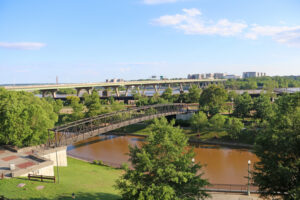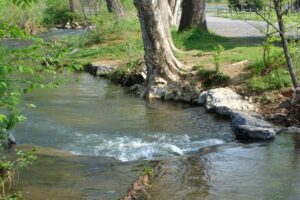 Maryland, Pennsylvania, New York, Delaware, West Virginia and the District of Columbia are the six jurisdictions that comprise the 64,000 square mile area that drains water into the Chesapeake Bay Watershed. Sixty percent of Virginia is in the Chesapeake Bay watershed. Virginia has four major rivers that drain directly into the Chesapeake Bay: the Potomac, Rappahannock, York and James rivers.
Maryland, Pennsylvania, New York, Delaware, West Virginia and the District of Columbia are the six jurisdictions that comprise the 64,000 square mile area that drains water into the Chesapeake Bay Watershed. Sixty percent of Virginia is in the Chesapeake Bay watershed. Virginia has four major rivers that drain directly into the Chesapeake Bay: the Potomac, Rappahannock, York and James rivers.
Why the Bay Matters
If you live far from the Chesapeake Bay, you may not feel connected to the importance of cleaning up the Bay. Nonetheless, the health of the Bay depends on the condition of the headwater streams even in the far reaches of the watershed, and a clean Bay benefits all Virginians.
The Chesapeake Bay provides habitat for many aquatic wildlife species. Oysters, mussels and the Chesapeake blue crab are just a few of the species critical to the Bay’s ecological community and fishing economy. The same stream restoration efforts that benefit these species also benefit upstream aquatic species as well. Trout and many amphibians depend on the clean water and the cooler stream temperatures provided by shaded waterways and wooded riparian buffers. Even those who do not live near the Bay can enjoy the seafood, recreational opportunities and ecological benefits that the Watershed provides.
Restoration Efforts
Chesapeake Bay restoration efforts began in 1970 with $27 million from Congress to conduct a 5-year study of the loss of wildlife and aquatic life in the Chesapeake Bay. In 1980, the study was published and identified excess nutrient pollution stemming primarily from land use changes as the primary cause for the Bay’s decline. Three years later, in 1983, the Environmental Protection Agency’s (EPA) first Chesapeake Bay Agreement set the goal to reduce pollution and restore the Bay watershed through a partnership with Maryland, Pennsylvania, Virginia, District of Columbia and the Chesapeake Bay Commission.
When the governors of Virginia (Chuck Robb, at that time), Pennsylvania and Maryland, along with the mayor of the District of Columbia, signed the Environmental Protection Agency’s 1983 Bay Agreement, they committed their jurisdictions to help with Bay cleanup efforts. These leaders called upon their residents to lend their support by:
- Supporting local watershed associations
- Protecting stream corridors that intercept pollutants
- Using less lawn and field fertilizers
- Encouraging sound land-use planning in their communities
- Planting more trees and shrubs along stream banks and shorelines
Ongoing Efforts
The original restoration intentions fell short of the considerable pollution reductions needed. Consequently, in 2010, the EPA established the Chesapeake Bay Total Maximum Daily Load (TMDL) which set limits on the amount of nutrients and sediment that can flow into the Bay from its tributary rivers and streams. To align with the TMDL limits, the Bay jurisdictions developed Watershed Implementation Plans (WIPs) that detail how each jurisdiction will meet the needed pollution reductions by 2025. For Virginia’s most recent WIP, visit Virginia DEQ Phase III WIP .
This plan explains the actions that localities in Virginia can take to secure cleaner rivers and streams and ultimately a cleaner Chesapeake Bay. The Chesapeake Bay Watershed Agreement has since been renewed and was most recently amended on January 24, 2020. For the first time, the Bay’s headwater states, West Virginia, New York and Delaware joined in full partnership to restore the Bay and its tributaries.
Among the actions that Virginia and the other Bay states have committed to are protecting our waterways by planting riparian forest buffers and increasing our urban tree canopy cover. DOF is supporting these actions though programs such as the Virginia Trees for Clean Water Grant Program.
Additional Resources
Learn more about the Chesapeake Bay Program restoration and partnership efforts.
| Image | Title | ID | Description | Content Type | View | hf:tax:document-category | hf:tax:Media |
|---|---|---|---|---|---|---|---|
 | Riparian Buffer Implementation Plan 2006-2010 | Report provides details of the implementation plan to support the Virginia Riparian Buffer Initiative. | Publication | View | watershed | publication | |
 | Riparian Forest Buffers – Forests on the Water’s Edge | P00140 | Publication is the effort of the Chesapeake Bay Program, including multiple states within the Chesapeake Bay Watershed, to educate the community leaders and the public about the benefits of riparian forest Buffers, their importance to watersheds for air quality, water quality and fish and wildlife habitat, forest Buffer losses and how we manage growth in riparian zones, how to maintain quality riparian forest Buffers, efforts in riparian forest restoration, and what you can do for forest Buffers. Printed copies available. | Publication | View | watershed | publication |
Contact Us
For more information or questions, e-mail us or use our contact form.



